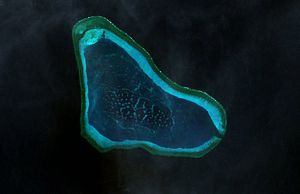Last week, following accounts by fishermen, the Philippines’ defense secretary, Delfin Lorenzana, confirmed that Filipino fisherman had access to Scarborough Shoal. “Since three days ago there are no longer Chinese ships, coastguard or navy, in the Scarborough area,” Lorenzana told reporters, according to Reuters.
Lorenzana since clarified that the claim made Friday was perhaps too hasty. China Coast Guard ships remain at the shoal, but Philippine fishermen are able to access the waters near Scarborough “unmolested.” Though the situation is no doubt an improvement from the status quo in the aftermath of the July 12 ruling by a Hague-based tribunal on the maritime disputes between Manila and Beijing in the South China Sea, it is not a return to the status of the shoal in 2012 — before China seized it from the Philippines following a stand-off.
Lorenzana on Sunday nevertheless described the situation at Scarborough as “a most welcome development.” Adding to Lorenzana’s assessment, the Philippine Presidential Communications Secretary Martin Andanar said, “The Palace welcomes the good development for our fishermen at the Panatag Shoal,” using the Philippine name for the shoal, which China calls Huangyan Dao.
On Monday, China clarified the state of play at Scarborough somewhat. Hua Chunying, spokesperson for the Chinese foreign ministry, said that the “Chinese side has always been exercising normal jurisdiction over Huangyan Dao.” She added: “The situation there is and will remain unchanged.”
“We have seen all-round improvement of China-Philippines relations following President Duterte’s visit to China. Under such circumstances, the Chinese side makes proper arrangements based on the friendship between China and the Philippines in response to the issue of President Duterte’s concern,” Hua continued.
The Chinese foreign ministry’s statement remains non-committal about the recent changes at Scarborough, which came after Philippine President Rodrigo Duterte’s closely watched visit to China, where he and his Chinese counterpart Xi Jinping concluded a range of agreements and agreed to sustain bilateral negotiations over the South China Sea dispute.
For Beijing, the recalibration at Scarborough Shoal bears several advantages. First, even though China does not recognize the legitimacy of the July 12 ruling, which found China’s capacious nine-dash line claim in the South China Sea invalid under the United Nations Convention on the Law of the Sea among other findings, by allowing Philippine fishermen access to the shoal, it is in effect complying with the ruling as far as Scarborough Shoal is concerned.
Second, China has proven itself adept at using carrots and sticks in managing its relationship with the Philippines as the South China Sea disputes have festered since the 2012 stand-off. Under the previous Philippine government of Benigno Aquino III, we saw mostly sticks deployed in the South China Sea. However, with Duterte, whose anti-Americanism runs deep, Beijing sees an apt opportunity to deploy carrots, leaving incentives for the unpredictable and volatile Philippine president to commit to bilateralism over the next year.
In particular, maintaining good ties with the Philippines with Scarborough Shoal as the nexus makes sense for China as Manila inherited the chairmanship of the Association of Southeast Asian Nations from Laos at the conclusion of the regional organization’s latest bout of summitry in Vientiane. In all these senses, an easing of tensions at Scarborough Shoal is cost-benefit no-brainer for China. (Beijing will incur few costs from nationalists at home and won’t be seen as “giving up” the shoal as there’s no indication that fishermen are entering the lagoon itself.)
What does all this mean for the future of the South China Sea disputes? It depends, of course, on the longevity of the China-Philippines bonhomie as the weeks and months carry on. Currently, Manila is largely seeing this development as a gesture of goodwill from China following Duterte’s visit — a sign that good things lie ahead if Duterte keeps up his continuing rhetoric on distancing Manila from Washington and pursues bilateral rapprochement with China.

































